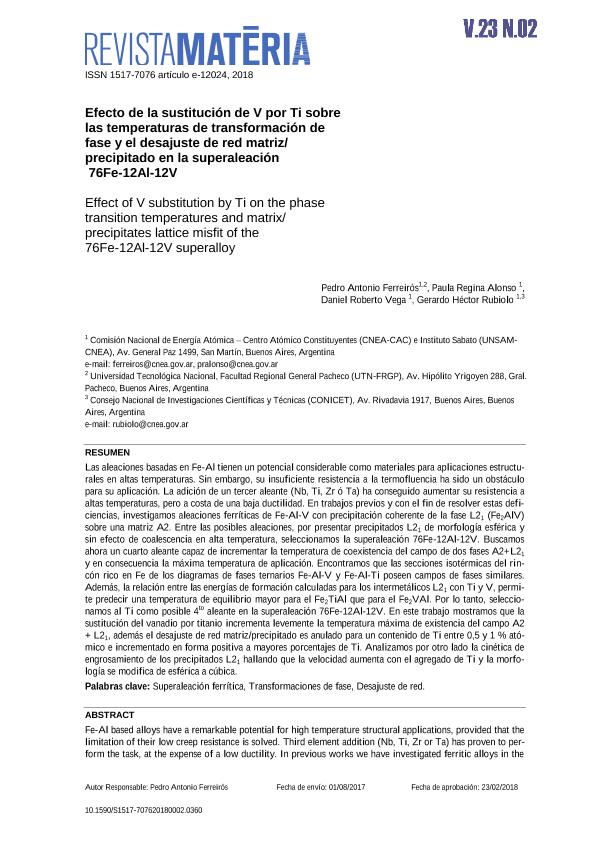Mostrar el registro sencillo del ítem
dc.contributor.author
Ferreirós, Pedro Antonio

dc.contributor.author
Alonso, Paula Regina

dc.contributor.author
la Vega, Rubén Darío

dc.contributor.author
Rubiolo, Gerardo Hector

dc.date.available
2020-03-06T20:57:09Z
dc.date.issued
2018-07
dc.identifier.citation
Ferreirós, Pedro Antonio; Alonso, Paula Regina; la Vega, Rubén Darío; Rubiolo, Gerardo Hector; Efecto de la sustitución de V por Ti sobre las temperaturas de transformación de fase y el desajuste de red matriz/ precipitado en la superaleación 76Fe-12Al-12V; Universidade Federal do Rio de Janeiro; Matéria; 23; 2; 7-2018; 1-9
dc.identifier.issn
1517-7076
dc.identifier.uri
http://hdl.handle.net/11336/99001
dc.description.abstract
Las aleaciones basadas en Fe-Al tienen un potencial considerable como materiales para aplicaciones estructuralesen altas temperaturas. Sin embargo, su insuficiente resistencia a la termofluencia ha sido un obstáculopara su aplicación. La adición de un tercer aleante (Nb, Ti, Zr ó Ta) ha conseguido aumentar su resistencia aaltas temperaturas, pero a costa de una baja ductilidad. En trabajos previos y con el fin de resolver estas deficiencias,investigamos aleaciones ferríticas de Fe-Al-V con precipitación coherente de la fase L21 (Fe2AlV)sobre una matriz A2. Entre las posibles aleaciones, por presentar precipitados L21 de morfología esférica ysin efecto de coalescencia en alta temperatura, seleccionamos la superaleación 76Fe-12Al-12V. Buscamosahora un cuarto aleante capaz de incrementar la temperatura de coexistencia del campo de dos fases A2+L21y en consecuencia la máxima temperatura de aplicación. Encontramos que las secciones isotérmicas del rincónrico en Fe de los diagramas de fases ternarios Fe-Al-V y Fe-Al-Ti poseen campos de fases similares.Además, la relación entre las energías de formación calculadas para los intermetálicos L21 con Ti y V, permitepredecir una temperatura de equilibrio mayor para el Fe2TiAl que para el Fe2VAl. Por lo tanto, seleccionamosal Ti como posible 4to aleante en la superaleación 76Fe-12Al-12V. En este trabajo mostramos que lasustitución del vanadio por titanio incrementa levemente la temperatura máxima de existencia del campo A2+ L21, además el desajuste de red matriz/precipitado es anulado para un contenido de Ti entre 0,5 y 1 % atómicoe incrementado en forma positiva a mayores porcentajes de Ti. Analizamos por otro lado la cinética deengrosamiento de los precipitados L21 hallando que la velocidad aumenta con el agregado de Ti y la morfologíase modifica de esférica a cúbica.
dc.description.abstract
Fe-Al based alloys have a remarkable potential for high temperature structural applications, provided that the limitation of their low creep resistance is solved. Third element addition (Nb, Ti, Zr or Ta) has proven to perform the task, at the expense of a low ductility. In previous works we have investigated ferritic alloys in the Fe-Al-V system with coherent precipitation of the L21 phase (Fe2AlV) in the A2 matrix. Among possible alloys, we chose the 76Fe-12Al-12V superalloy for filing a L21 precipitation with spherical morphology and void coalescence at high temperature. The new task is to find a fourth alloy element in order to increase the temperature equilibrium of the two phases A2+L21 field and consequently the maximum application temperature. Isothermal sections of the Fe rich corner on ternary Fe-Al-V and Fe-Al-Ti phase diagrams have similar phase fields. Besides, by comparing the formation energies between L21 intermetallics of Ti and V, it is expected a higher equilibrium temperature for the Fe2TiAl than for Fe2VAl. Therefore we select titanium as a possible 4th alloy element in the 76Fe-12Al-12V superalloy We show in this work that vanadium substitution by titanium slightly increases the temperature limit for the A2 + L21 phase field while cancelling the lattice misfit between matrix and precipitates for Ti content between 0.5 and 1 at. % and positively increasing it for Ti contents greater than 1 at. %. Besides, we demonstrate that coarsening rate is increased with Ti addition and morphology is modified from spherical to cubic.
dc.format
application/pdf
dc.language.iso
spa
dc.publisher
Universidade Federal do Rio de Janeiro

dc.rights
info:eu-repo/semantics/openAccess
dc.rights.uri
https://creativecommons.org/licenses/by-nc-sa/2.5/ar/
dc.subject
SUPERALEACIÓN FERRÍTICA
dc.subject
TRANSFORMACIONES DE FASE
dc.subject
DESAJUSTE DE RED
dc.subject.classification
Ingeniería de los Materiales

dc.subject.classification
Ingeniería de los Materiales

dc.subject.classification
INGENIERÍAS Y TECNOLOGÍAS

dc.title
Efecto de la sustitución de V por Ti sobre las temperaturas de transformación de fase y el desajuste de red matriz/ precipitado en la superaleación 76Fe-12Al-12V
dc.title
Effect of V substitution by Ti on the phase transition temperatures and matrix/ precipitates lattice misfit of the 76Fe-12Al-12V superalloy
dc.type
info:eu-repo/semantics/article
dc.type
info:ar-repo/semantics/artículo
dc.type
info:eu-repo/semantics/publishedVersion
dc.date.updated
2020-03-04T15:43:35Z
dc.journal.volume
23
dc.journal.number
2
dc.journal.pagination
1-9
dc.journal.pais
Brasil

dc.journal.ciudad
Río de Janeiro
dc.description.fil
Fil: Ferreirós, Pedro Antonio. Universidad Tecnológica Nacional. Facultad Regional General Pacheco; Argentina. Universidad Nacional de San Martín. Instituto Sabato; Argentina. Comisión Nacional de Energía Atómica; Argentina
dc.description.fil
Fil: Alonso, Paula Regina. Comisión Nacional de Energía Atómica; Argentina. Universidad Nacional de San Martín. Instituto Sabato; Argentina
dc.description.fil
Fil: la Vega, Rubén Darío. Universidad Nacional de San Martín. Instituto Sabato; Argentina. Comisión Nacional de Energía Atómica; Argentina
dc.description.fil
Fil: Rubiolo, Gerardo Hector. Universidad Nacional de San Martín. Instituto Sabato; Argentina. Consejo Nacional de Investigaciones Científicas y Técnicas; Argentina. Comisión Nacional de Energía Atómica; Argentina
dc.journal.title
Matéria

dc.relation.alternativeid
info:eu-repo/semantics/altIdentifier/doi/https://doi.org/10.1590/s1517-707620180002.0360
dc.relation.alternativeid
info:eu-repo/semantics/altIdentifier/url/http://ref.scielo.org/yn2v9h
Archivos asociados
